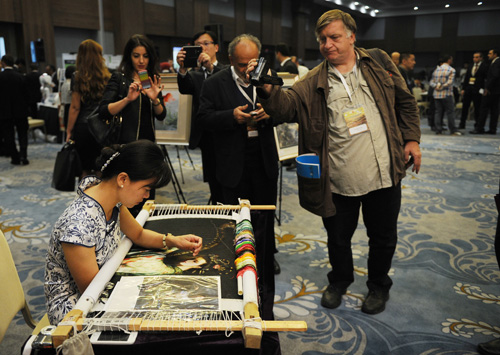|
 |
|
SHARED VISION: A Chinese silk embroidery artist works on her creation on the sidelines of an international seminar on the ancient Silk Road held in Istanbul, Turkey, on October 28, 2013 (LU ZHE) |

It is now unquestionable that the Asia-Pacific region is becoming the global economic center of the 21st century, currently accounting for 57 percent of global GDP. However, severe security problems remain a challenge, resulting in the rise of geopolitical wrangling and distrust within the region. The Korean Peninsula is still on the edge of conflict; Japanese politics continue to shift right; territorial and maritime disputes are simmering in South Asia and the Asia-Pacific; and West Asia remains unstable. Meanwhile, many countries in the region are plagued by terrorism, extremism, separatism, and organized crime as well as drug trafficking.
Due to the fragmented development mode of the region after the Cold War, they lack efficient economic integration, which runs counter to the trend of economic globalization. The region extends outside the world economic integration process characterized by "one axis with two wings"—the North American Free Trade Area plus the Trans-Pacific Partnership and the Transatlantic Trade and Investment Partnership—dominated by the United States and the EU. Along with a multilateral service trade agreement, this process will form a new kind of "WTO" led by Western countries.
Against this backdrop, the Conference on Interaction and Confidence Building Measures in Asia (CICA) seeks to play a stabilizing role in fostering security in the region. In the spirit of peace, harmony and unity, it is committed to strengthening dialogue, trust and cooperation among Asian countries. It also strives to promote joint development in order to build a new Asia of peace and stability. China will work with other CICA members to improve the mechanism, deepen cooperation and implement confidence building measures.
The Shanghai Summit of the CICA, scheduled to be held in May, will feature themes of security, cooperation and development. Economic development is an important part of the CICA, as security and economic growth build on one another. The CICA strengthens economic ties through encouraging mutual trade and investment among its members. Its economic cooperation mainly focuses on developing various forms of traffic networks; building a safe and effective transportation corridor; improving efficiency and security of regional transportation and energy supply; expanding trade, investment, finance and tourism cooperation among member states; encouraging communication and cooperation in the field of information technology; and establishing an economic and trade database.
Creating impetus
The initiatives of the Silk Road Economic Belt and the Maritime Silk Road of the 21st Century proposed by Chinese President Xi Jinping will become an important driving force for economic cooperation among CICA member states.
The two initiatives have formed a new pattern for China's all-round opening up and a new framework for its neighborhood diplomacy, marking a substantial change in its opening-up strategy. The country is moving away from its strict focus on attracting foreign investment, seeking equilibrium between foreign investment and investment overseas. As it reaches out to countries to its west, China will speed up the development of its western region. Meanwhile, by pushing for free trade agreements (FTAs) with its neighboring countries, it aims to promote the free flow of labor, capital and commodities in keeping with the trend of world economic integration.
The Silk Road Economic Belt is based on the opening up and development of China's western region. China will build the second Eurasian Land Bridge that runs through the northwest part of the country and links the Pacific Ocean to the Baltic Sea. It will speed up its cooperation on energy and infrastructure development with Central Asian countries. It will also promote the establishment of an FTA with the EU. All these efforts will help connect Central Asia with the EU, the largest economy in the world, and Asia-Pacific region, the world's economic center of gravity. The China-Pakistan Economic Corridor will serve as a passageway connecting China's Xinjiang Uygur Autonomous Region with the Indian Ocean. In addition, the Bangladesh-China-India-Myanmar Economic Corridor will link China's southwest with Southeast Asia.
|
